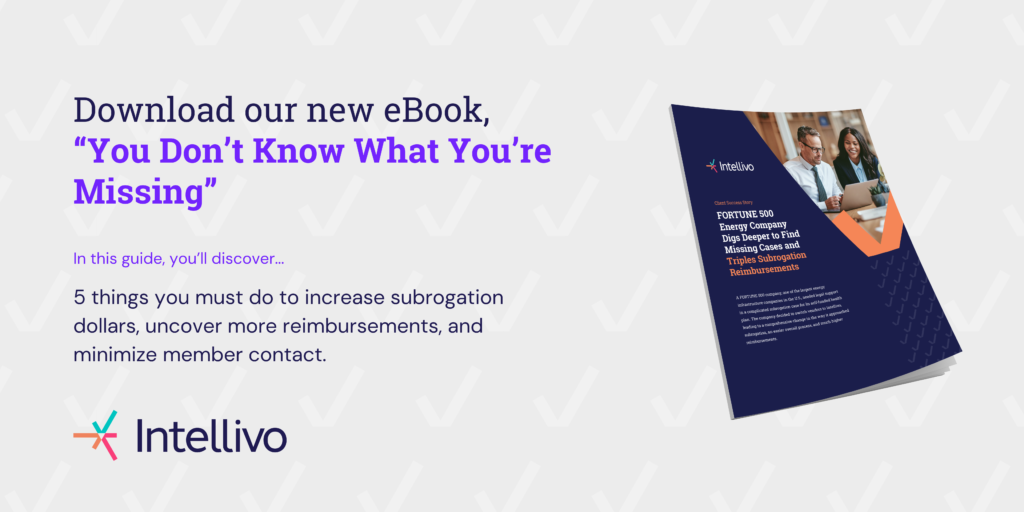It happens thousands of times a day. A health plan member gets rear-ended at a red light or is involved in a fender bender on the freeway.
The plan member seeks medical care for neck pain or some other injuries caused by the accident. The treating provider then submits the claim for services to the health insurance carrier, coding for treatment related to neck pain without explicitly indicating that the injuries resulted from a motor vehicle accident.
This simple visit to a medical provider triggers a claims processing pileup that can take months to clear:
- Since neck injuries are common with car accidents, after paying the bill, the health plan’s system flags the medical charge to determine whether another insurance policy, such as the at-fault driver’s auto insurer, should be financially responsible for the injury. In other words, the health plan might be owed a reimbursement.
- The health plan’s subrogation vendor then sends a series of subrogation questionnaires to the plan member, asking if the injury was related to an accident.
- Unsure whether the letter is legitimate, the plan member sets the information request aside, and it eventually lands in the recycling bin.
- Without a response from the plan member, the health plan discontinues their investigation and ends up paying for expenses that would have been covered by an auto policy.
The Stakes Are Too High for Status Quo Subrogation Processes
Motor vehicle accidents (MVAs) account for a major share of subrogation recoveries, but our data indicates that 56% of MVA-related claims are not coded as such by providers. That means the onus falls on subrogation teams to identify them after the fact.
As Intellivo CEO Laura Hescock explained in a recent BenefitsPro webcast, “You want to make sure that a health plan gets all the recoveries they’re owed, so you’re going to cast a very wide net. You’re going to reach out to any plan member who has indications of an injury that could be related to an auto accident. And that is obviously very inefficient, as plan members take a long time to respond, if they respond at all.”
Sending questionnaires to determine the cause of an injury and confirm whether a third party may be liable for a claim has long been standard operating procedure. But relying on generic accident questionnaires comes with three critical issues:
1. Low Response Rates
Intellivo data shows that only 15% of accident questionnaires are ever completed. Of those, only 4% result in a successful recovery. That means a large number of potentially recoverable claims are never identified or investigated, simply because members don’t respond.
2. Negative Member Experience
From the member’s point of view, these questionnaires often seem confusing or intrusive. They’re sent by unfamiliar third-party vendors and may arrive weeks after the care episode. For members dealing with the aftermath of an injury, the forms feel like unnecessary red tape—or worse, a scam.
Even when the intent is legitimate, the member may not understand what subrogation is or why they’re being asked to provide accident details. That confusion can quickly turn into dissatisfaction with the plan itself.
3. Administrative Burden and Inefficiency
Tracking subrogation cases is resource-intensive for TPAs and internal plan administrators. If a member doesn’t respond to the first questionnaire, they often send it out multiple times to determine what caused an injury and whether the medical claim is reimbursable. Each unanswered questionnaire represents not only a missed recovery opportunity but also time wasted on a process with diminishing returns.
Smarter, Tech-Driven Subrogation Improves Results with Zero Member Contact
Modern subrogation technology automatically determines which claims are eligible for reimbursement. This allows health plans and TPAs to maximize reimbursements without bothering members with confusing questionnaires or overwhelming their admin teams.
Modern solutions like Intellivo drastically reduce the need for subrogation questionnaires by providing:
- Automated case identification using advanced analytics and third-party data sources such as accident reports and P&C claims
- Virtually eliminating member contact unless absolutely necessary, using data enrichment to verify claim details
- Real-time referral systems that replace manual, case-by-case data gathering with ongoing, batch-level claim analysis
- Integrated dashboards for better transparency and tracking of recovery progress
These modern solutions don’t just reduce friction; they drive measurable results. One large TPA working with Intellivo more than doubled its recovery volume while streamlining its administrative workload and eliminating unnecessary member outreach.
Open the Door to Smarter, Frictionless Subrogation
The traditional questionnaire model may have served a purpose in the past, but today it’s a barrier to better outcomes. Health plans and TPAs that modernize their subrogation approach can improve recovery rates, protect the member experience, and reduce internal inefficiencies—all without relying on outdated, low-yield forms.
For more insights on maximizing reimbursements without disrupting the member experience, download You Don’t Know What You’re Missing.
Test Test Test Test Test Test Test Test Test Test Test Test Test Test Test Test Test Test Test Test Test Test Test Test Test Test Test Test Test Test Test Test Test Test Test Test Test Test Test Test Test Test Test

